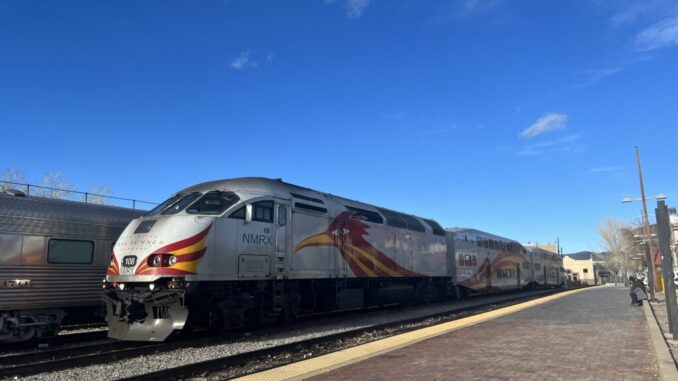
Alix Bliss wants to live in New Mexico without owning a car. The newcomer to the state waited for the Rail Runner at the Santa Fe Depot Station on Monday afternoon with his bike, both of which have replaced driving for him.
Bliss is originally from Olympia, Washington, where he said the public transportation made commuting easier for him. He’s satisfied with the trips he’s taken on the Rail Runner but said that its route is limited, and he’s yet to find options that take him everywhere he wants to go.
“I don’t have (a car) now, and it’s fine to get around here. But if I want to go somewhere like Taos or up in the mountains, then I’d need one,” Bliss said.
Two bills pre-filed in the state Legislature ahead of the session that starts Tuesday may pave the way for expanded rail service in New Mexico.
Sen. William Soules (D-Las Cruces) introduced the proposals to bring a high-speed rail line through the entire state, and into Colorado to the north and Chihuahua, Mexico, to the south.
The bills would allocate $500,000 for a feasibility study and $1 billion for the rail project itself.
Soules introduced the same measures in the 2022 legislative session. Both died without being heard by all their assigned committees. Only the Senate Tax, Business and Transportation Committee recommended passing the legislation to study what it will take to create a longer, high-speed rail line.
The economic boon would outweigh the billions in startup costs, Soules said.
“Everyone in New Mexico will benefit,” Soules said. “Moving people, goods and ideas is what economic development is all about. This would have a huge economic impact for years and years to come.”
Commuters at the Santa Fe Depot station said a high-speed rail system would improve their commutes and expressed support for such a project.
Their views are in line with many Americans.
A poll by the Rail Passengers Association last year found that 78% of people wanted more investments in passenger rail, and 66% of respondents said it was “important” to have a robust passenger rail system.
Robert Fowler, an accountant who lives in Albuquerque, has a 12-hour workday that includes commuting on the Rail Runner to his job in Santa Fe. He has to take a train at 6 a.m. to make it to work around 8 a.m. Fowler said he sees crowded trains every day, often with the same people riding, and would like having a transit option that is faster and travels later in the day.
“I was just talking to my wife about this and she said, ‘Gee, it takes you two hours to get home from work,’” Fowler said. “I think with (high-speed rail) I’d have some extra time. It would definitely cut that time down for everyone.”
Neighboring states such as Colorado and California have contended with constructing high-speed rail systems, though these efforts hit snags with funding and pulling bipartisan support.
A feasibility study from the Rocky Mountain Rail Authority found that construction of a high-speed rail line in Colorado was doable and foreshadowed a possible vote on a plan in 2020. That did not come to fruition. Colorado is still moving forward with the Front Range Rail Project — a 191-mile track that would connect the cities of Fort Collins and Pueblo — with slower and cheaper trains. But it’s years away from construction as the Southwest Chief & Front Range Passenger Rail Commission assembles a plan and finds funding.
California’s high-speed rail system is behind on construction and has spent billions on a proposed high-speed line between the northern and southern parts of the state without a single mile of track laid.
The Trump administration canceled nearly $1 billion in federal funding to California’s rail project in 2019, a stark contrast to his predecessor Barack Obama’s nationwide push for high-speed rail. The Obama-era project failed due to funding woes and a lack of support.
President Joe Biden has since restored California’s canceled high-speed rail funding, and called for a dramatic increase in passenger rail funding. The White House said in a statement last year that the $73 million in public transportation funding it received from Biden’s infrastructure bill would “expand healthy, sustainable transportation options in New Mexico, where non-white households are more likely to commute via public transportation.”
Despite several false starts, commuters still want more public transit options. A 2022 study from the University of California Berkeley’s Institute of Government Studies found that 56% of California voters still wanted the high-speed rail line despite more than a decade of roadblocks.
The project in New Mexico would be no easy feat, Soules said. It is likely that governors from other states, the federal government and even the presidents of the U.S. and Mexico may have to be involved in the decision-making if the train is built to its intended scope.
“This is not something that can only be done in Santa Fe,” Soules said. “In order to do it well and do it right, we would need international support. Governors would be involved and that’s way above my pay grade. But we have to start somewhere, and my role is to start a conversation about what could be accomplished.”
Some commuters want to see a clearer vision before throwing support at a high-speed rail plan. Susan Beltran, who works for the New Mexico Children, Youth and Families Department, said she takes the Rail Runner every day for work and loves the experience, but she’s hesitant to support high-speed rail without a plan.
Beltran likes the idea of more public transportation. She said price, commute time and location stops are most important to her before buying a ticket.
For Fowler, the accountant from Albuquerque, a faster train with more destinations would allow him to travel more and even make his leisure commutes to Santa Fe easier, since he and his wife also have friends and family they visit in their free time.
“If we want to have a night out in Santa Fe, we have to arrive much earlier than when anything starts,” he said. “It’s good that the last train can take us back pretty late, but more scheduled times and faster trips would let us leave a little later and be more convenient.”
The New Mexico high-speed train would be subsidized by the public sector and not rely on ridership, so it wouldn’t need to depend on ticket sales in its tenuous early years, Soules said.
Other details would have to be worked out on a larger scale but would start to become clear if the feasibility study is approved, he said.
The project may be ambitious and costly.Soules said there’s evidence that high-speed rail is worth the investment.
“All I know is that everywhere in the world that has high-speed rail isn’t talking about taking them out,” he said. “They’re talking about expanding it.”


